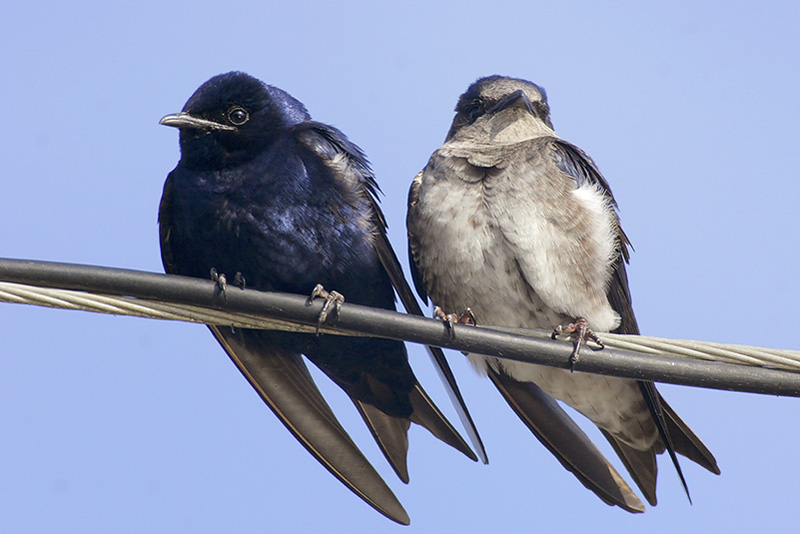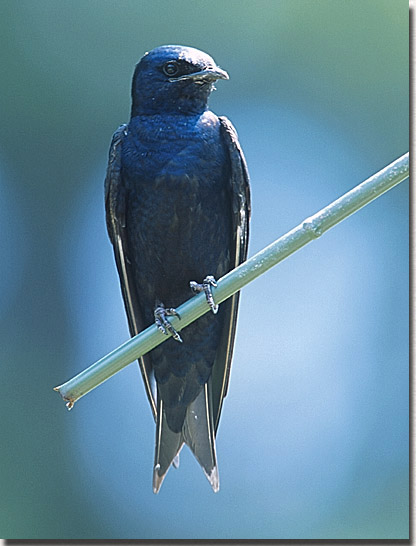
As a Purple Martin landlord you can take either a passive or active approach to managing your colony. Those assuming a more active role will usually have a more successful colony. At a minimum, when first establishing your colony, plan on spending some time protecting the nesting area from House Sparrows and starlings until the colony becomes established.
Nest checks are an important part of managing your colony. The nesting system you selected should be easy to raise and lower to allow easy nest checks. Watch for signs of House Sparrows or starlings establishing an early presence or trying to invade the colony.
Remove any nesting material belonging to either of these intruding species. Lowering and raising the housing to do a nest check will not bother the martins significantly, even with young in the nest. (During nesting do not lower the house if your pole is hinged and swings the house to the side as it is lowered.)
Purple Martins are very sensitive to the location of their house. Be sure to raise the house to the exact same height and with the exact same orientation each time you perform a nest check.
Do not do nest checks in high winds or in mist and rain. The exposure may be harmful to young birds.

purple martin
Feeding Purple Martins
Since martins feed solely on flying insects there is little that the landlord can or needs to do in providing supplemental food. Martins are, however, vulnerable to weather conditions that affect insect availability. (Some martin landlords report throwing crickets into the air, which the martins quickly learn to grab.)
Martins are at the greatest risk early in the year when late cold snaps can reduce the insect activity and population.
 Some landlords provide crushed eggshells during the breeding season. The crushed shells should be placed on a platform feeder attached to the purple martin house or on the mounting pole. In bad weather try placing meal worms or crickets on the feeding platform.
Some landlords provide crushed eggshells during the breeding season. The crushed shells should be placed on a platform feeder attached to the purple martin house or on the mounting pole. In bad weather try placing meal worms or crickets on the feeding platform.
If the birds have learned to accept the eggshell they will sometimes feed on the meal worms and crickets. The egg shell should be crushed, cleaned and dried. Heating the eggshell in the oven until the edges start to turn brown may make them more palatable.
Control of House Sparrows and Starlings
Controlling House Sparrows and starlings can be one of the more difficult jobs in establishing a purple martin colony. Remove nesting material from these species as soon as it is placed in the martin house. Purple Martin nests are flat, usually with some mud and sometimes green leaves. Starlings and House Sparrow nests are a thick collection of straw, grass and trash that will usually fill up the nesting cavity.
Starlings can usually be controlled by using aluminum homes with a 6 in. by 6 in. nest compartment. They are also less likely to nest in gourds. A new crescent-shaped access hole has also proven to be successful in preventing starlings from using the nesting box.
House Sparrows can be more difficult. If removing the nest material is a losing battle, the martin landlord may have to resort to a sparrow trap.
Nesting materials for Purple Martins
Landlords can supply nesting materials. Dried pine needles, clean dry twigs, or straw can be scattered in an open area and may be picked up by the martins.
Keep a small, non-grassy area soaked with water to provide a source of mud.
Predators
Small animals such as raccoons, possums and snakes can raid martin nests. A good precaution is to place a baffle on the pole that prevents snakes and small mammals from crawling up the pole. Several commercial baffles are available and homemade baffles are easy to produce and can be just as effective.
To discourage predators, keep the base of the pole clean and free of shrubs, vines and tall grass.
In some areas owls can be a problem. Owl guards can be a homemade screen or a commercially available product.
End of season clean up
Clean houses at the end of the nesting season with a 10% bleach and water solution. Dry completely. Either store the house or close the nesting holes to prevent unwanted visitors.

